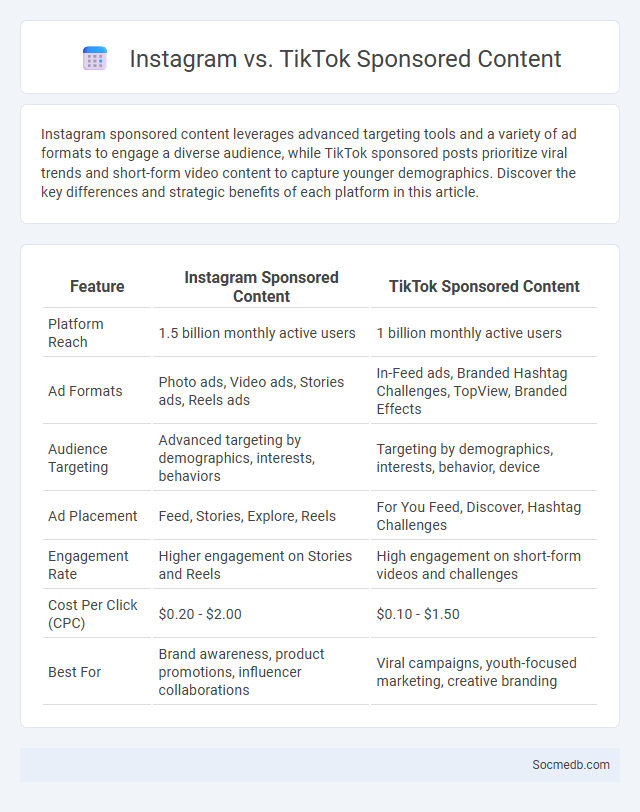
Photo illustration: Instagram vs TikTok Sponsored Content
Instagram sponsored content leverages advanced targeting tools and a variety of ad formats to engage a diverse audience, while TikTok sponsored posts prioritize viral trends and short-form video content to capture younger demographics. Discover the key differences and strategic benefits of each platform in this article.
Table of Comparison
| Feature | Instagram Sponsored Content | TikTok Sponsored Content |
|---|---|---|
| Platform Reach | 1.5 billion monthly active users | 1 billion monthly active users |
| Ad Formats | Photo ads, Video ads, Stories ads, Reels ads | In-Feed ads, Branded Hashtag Challenges, TopView, Branded Effects |
| Audience Targeting | Advanced targeting by demographics, interests, behaviors | Targeting by demographics, interests, behavior, device |
| Ad Placement | Feed, Stories, Explore, Reels | For You Feed, Discover, Hashtag Challenges |
| Engagement Rate | Higher engagement on Stories and Reels | High engagement on short-form videos and challenges |
| Cost Per Click (CPC) | $0.20 - $2.00 | $0.10 - $1.50 |
| Best For | Brand awareness, product promotions, influencer collaborations | Viral campaigns, youth-focused marketing, creative branding |
Understanding Sponsored Content on Instagram and TikTok
Sponsored content on Instagram and TikTok involves paid partnerships where creators promote brands within their posts or videos, blending advertising with authentic engagement. You should recognize clear disclosures like "Sponsored" or "Ad" to distinguish paid promotions from organic content, ensuring transparency and trust. Understanding algorithms that prioritize sponsored content helps maximize reach and optimize campaign performance on these platforms.
Key Differences in Platform Demographics
Social media platform demographics vary significantly, with Instagram attracting a younger audience primarily aged 18-29, while Facebook retains a broader user base including older adults aged 30-65. LinkedIn predominantly serves professionals aged 30-49, ideal for B2B marketing and networking. Understanding these key differences helps you tailor content and ad strategies to match your target audience effectively.
Content Formats: Instagram vs TikTok Sponsorships
Instagram sponsorships emphasize polished images, carousel posts, and Stories with swipe-up links, targeting audiences through visually curated content and influencer partnerships. TikTok sponsorships leverage short-form video trends, viral challenges, and authentic user interactions, maximizing reach with algorithm-driven content discovery. Brands choose Instagram for brand storytelling and consistent aesthetic, while TikTok excels in dynamic engagement and rapid viral potential.
Algorithm Impact on Sponsored Reach
Social media algorithms prioritize content based on user engagement, significantly limiting the organic reach of sponsored posts unless they achieve high interaction rates. Advertisers must optimize targeting and content quality to align with algorithmic preferences, ensuring sponsored posts reach the intended audience effectively. The algorithm's impact often leads to increased ad spend to maintain visibility, highlighting the importance of strategic campaign management in social media marketing.
Engagement Rates: Which Platform Delivers More?
Engagement rates vary significantly across social media platforms, with Instagram and TikTok consistently delivering higher user interaction compared to Facebook and Twitter. Your brand's success on these channels depends on leveraging visual content and short-form videos, which drive likes, shares, and comments more effectively. Analyzing platform-specific metrics helps tailor your strategy to maximize reach and engagement.
Influencer Collaboration Opportunities
Influencer collaboration opportunities on social media platforms significantly amplify brand visibility and engagement by leveraging authentic content tailored to target audiences. Strategic partnerships with micro and macro influencers drive higher conversion rates through trusted recommendations and niche market penetration. Leveraging analytics tools to identify high-performing influencers ensures optimized campaign reach and return on investment.
Cost Comparison: Instagram vs TikTok Sponsored Content
Sponsored content on Instagram typically involves higher average costs per engagement compared to TikTok, reflecting Instagram's established user base and advanced targeting options. TikTok offers competitive pricing with a rapidly growing audience, especially appealing for brands targeting younger demographics through organic-feeling, creative video ads. Evaluating your campaign goals and budget, you can optimize your social media marketing by choosing the platform that delivers greater ROI for sponsored content investments.
Brand Safety and Transparency
Brand safety on social media ensures that advertisements appear alongside content that aligns with a company's values, preventing damage to brand reputation from association with harmful or inappropriate material. Transparency in social media advertising involves clear disclosure of sponsored content and detailed reporting on ad performance metrics, fostering trust between brands and consumers. Platforms employing advanced AI-driven content moderation and real-time analytics enhance brand safety measures while providing advertisers with transparent insights to optimize their campaigns effectively.
Measuring ROI on Sponsored Campaigns
Measuring ROI on sponsored social media campaigns involves tracking key performance indicators such as click-through rates (CTR), conversion rates, and cost per acquisition (CPA) to evaluate financial effectiveness. Utilizing advanced analytics tools like Facebook Ads Manager and Google Analytics enables precise attribution of revenue generated from ad spend. Regularly analyzing these metrics helps marketers optimize campaign strategies, ensuring maximum return on investment and budget efficiency.
Choosing the Right Platform for Your Sponsored Content Strategy
Selecting the ideal social media platform for your sponsored content strategy depends on your target audience demographics, content type, and campaign goals. Platforms like Instagram and TikTok excel in visual and short-form video content, while LinkedIn suits B2B engagement and professional networking. Analyzing user behavior metrics and platform-specific advertising tools ensures maximum reach and ROI for your sponsored campaigns.
 socmedb.com
socmedb.com